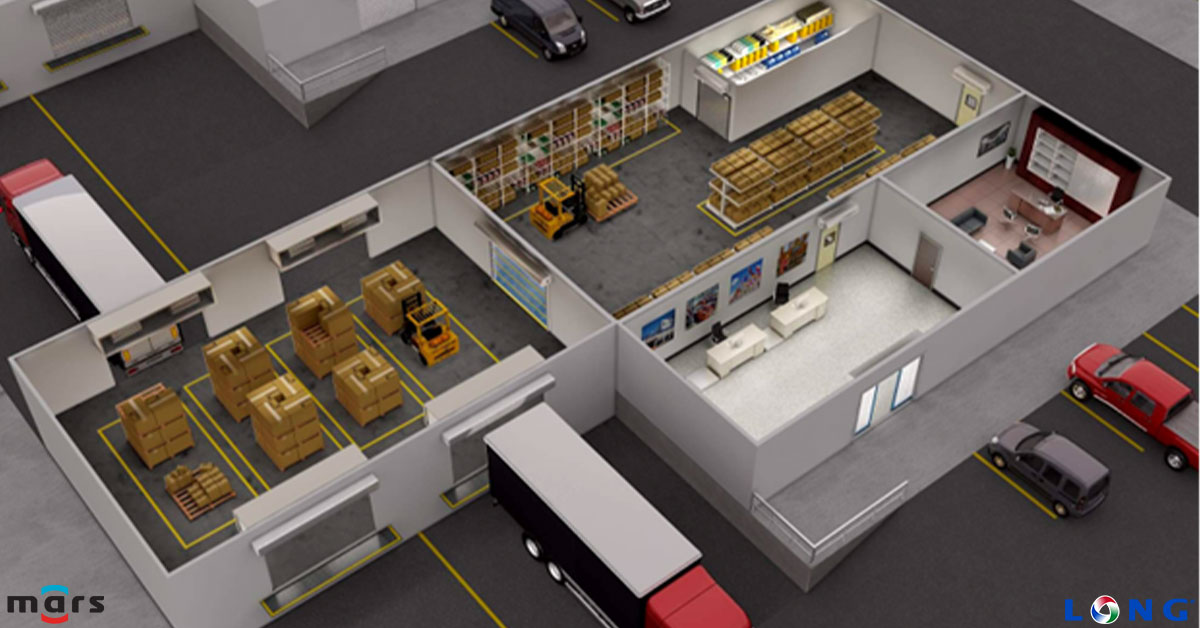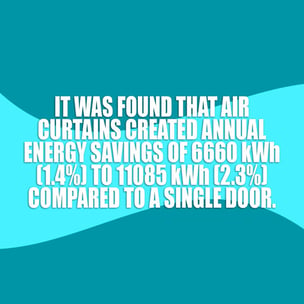How to Select the Right Air Curtain to Match Your Needs

This article was written in conjunction with our partners at Mars Air
Air curtains (or air doors) are devices that produce a controlled stream of air across building entryways or openings to create an environmental separation between two spaces. They're extremely versatile and widely used to regulate temperature, keep flying insects out, and block smoke and contaminants.
Even though their blowers run on electricity, air curtains reduce the load on your air-conditioning or heating systems and minimize heating and cooling losses due to the continuous opening and closing of doors at commercial facilities.

This results in substantial net energy savings, making them a lucrative option across industries. In a study by the Air Movement and Control Association International, Inc. (AMCA), it was found that air curtains created annual energy savings of 6660 kWh (1.4%) to 11085 kWh (2.3%) compared to a single door.
However, it's extremely important to ensure that you have the right product. Installing one whose specs don't match your needs can land you in a lot of trouble. This article discusses the things you should keep in mind when specifying air curtains and how to make the right choice.
Factors to consider when specifying air curtains
When choosing an air curtain, you must take into account a building’s specific requirements. Buying a really powerful air curtain for a small space could be overkill. Its cost and energy consumption may create zero net savings for you.
Likewise, a less powerful one may not create a strong enough airstream for your needs. But those aren’t the only factors to consider. Let's take a look at some of the most important ones:
1. Building size
Bigger buildings (with several floors) will have greater air volume and more openings than smaller ones. Larger buildings typically also have more stable internal pressures. On the other hand, pressurization in smaller buildings with multiple doors tends to be unstable; whenever an entryway is breached, others with air curtains get affected.
So, an air curtain meant for a supermarket will have very different specs compared to a small fast-food restaurant. Likewise, large industrial air curtains may be great for stadiums and subway stations that have vast open spaces.
2. Entryway size
It's important that your air curtain covers the entire width of an entryway. If not, outside air may enter through the gaps, rendering the air curtain ineffective. If it's too wide, you may need to install multiple air curtain units working in tandem to prevent the infiltration of flying insects and pollutants or the loss of conditioned air.
Likewise, the height of your entryway will determine the air velocity your air curtain needs to provide. If the doorway is pretty tall — such as in a warehouse — you'll need a high air velocity to create an optimum obstruction.
Remember that this is the velocity at the discharge nozzle. The airspeed will diminish as it reaches the bottom, so your employees won't experience any discomfort or inconvenience.
Obviously, an air curtain for your restaurant's drive-thru window doesn't need such high velocity. If the airflow is too strong, it will make more noise and won't be quite energy-efficient. That's why it's important to measure the dimensions of your entryways accurately so you can buy air curtains that best suit your needs.
3. Type of entryway
Your choice of air curtain will also depend on the type of opening you want to cover. Is your door manual, automatic, revolving, or always open?
If you have open doors to permit the free flow of customers and staff, you will require an air curtain that is perpetually on. However, if you have automatic vestibule doors, you will need curtains with automatic door switches that run only when the doors open and stop when they close. Likewise, for revolving doors, you may need a different kind of air curtain.
It's also important to consider how frequently your doors open. Quick-service restaurants are likely to have a greater frequency of opening/closing compared to educational institutions.
All this will determine if you need air curtains that function continuously, semi-continuously, or switch on a few times an hour.
4. Building complexity
The type of air curtain you need will also depend on the complexity of the building. For example, industrial buildings or warehouses with multiple entryways, or spaces that have a large pressure difference between the interior and the exterior, can be quite tricky.
These can cause your otherwise correctly-sized air curtain to function sub-optimally. In such cases, it may be advisable to use multiple units or industrial air curtains to combat these issues.
5. Expected wind load
The geographical location of a building will determine the expected wind exposure of its entryways. Typically, if the area is quite windy, you'll need a more powerful air curtain. This is to create a stronger air barrier against the wind that could otherwise render your curtain ineffective.
Other factors such as the direction of your entryways relative to prevailing winds and the presence of walls or buildings nearby will also need to be considered when specifying air curtains.
6. Air pressure
The difference in pressure between your indoor air and the outside air will determine the direction of air movement. If the differential is too high, it will accelerate the circulation. So, you'll need a more powerful curtain with high velocity to separate your indoor and outdoor environments effectively.
Keep in mind that standard air curtains are typically not equipped to deal with negative pressure situations. As such, most buildings designed properly with HVAC have positive pressure which helps air curtains perform well. But if negative pressurization is involved, you may need a special type of air curtain or a modified one that's customized in its installation to help offset this condition.
7. Application
You must also consider the purpose of your air curtain. What are you going to use it for? Do you need it for flying insect control at your restaurant, climatizing the indoor air at your retail store, or maintaining your freezer/cold storage at its optimal temperature? These are important considerations that should govern your decision.
Also, in certain facilities like libraries or cafeterias, a noise-free environment may be the most important requirement. In such cases, you’ll need to specify smaller air curtains that don’t produce unnecessary noise.
Restaurants or salons that are very particular about being on-brand, may want to blend their air curtains into their color schemes. In such cases, a specifier may also need to ensure that their finishes and designs fit those themes perfectly.
Why specifying air curtains correctly is crucial
For engineers, contractors, and designers, specifying air curtains is an extremely critical phase of designing/constructing a commercial building. Often, air curtains are a necessity that enhances the effectiveness of a building's HVAC system and minimizes any loss of heat or climatized cold air.
Plus, they directly impact a building's eco-friendliness by accruing energy savings. Air curtains are also known to reduce energy losses by 80% compared to thru and open doors.
Sometimes, you may need to integrate an air curtain with a building's existing HVAC system, keeping in mind its structural, architectural, and electrical design. This requires a thorough understanding of product specs to make sure you can integrate it seamlessly.
How to specify air curtains correctly
To specify an air curtain, you'd typically start with the size of your entryway and wind load and balance them against a product's capacity, air thickness, discharge velocity, etc., to arrive at the correct model. When these specs aren't accurate (which is quite common in the industry), your job gets even more difficult.
Thankfully, one great resource you can rely on is the Mars Product Selector. The tool will guide you through a series of questions to capture all the necessary information about your needs.
- First, it will ask you to select your primary industry from options such as Restaurant and Foodservice, Refrigeration and Cold Storage, Entertainment Venues, Convenience, Grocery and Retail Stores, etc.
- Based on your selection, it will guide you through a series of questions to understand your specific application or purpose. For example, if you’ve selected Restaurant and Foodservice as your primary industry, it will ask you to choose from Sanitation, Cold Storage, or Architectural Models in the next step.
- You can get even more specific. For example, if you’ve selected Sanitation, it will ask you to choose from Flying Insect Control, Pathogen Control, etc.
- Finally, it will ask you to enter the mounting height. Once you have done so, it will present you with the best air curtain options for your building or facility.
Final words
An air curtain is indispensable when it comes to regulating indoor air temperature while creating substantial energy savings. However, most air curtain manufacturers have a large assortment of products of varying specs. This often makes it difficult for specifiers to find the right one for their projects keeping in mind a building's size, complexity, and other ambient factors.
Specifying the right product is crucial. Once installed, if it doesn't perform appropriately, dismounting and transporting it back to the vendor can be quite a task due to its size and weight. Plus, it will involve additional costs, labor, managing logistics, and risks of damage. Also, if the product doesn't adequately serve your purpose, it's unlikely that you'll get any energy savings at all.
To avoid these issues, keep in mind the factors mentioned above when specifying air curtains. And of course, our LONG representatives are hear to help make you life easier by assisting in finding the the right air curtain for your needs.
Topics
Subscribe to Updates

Joslyn is the digital marketing coordinator for LONG. She loves to hike and play volleyball when the weather is warm and spends her free time reading, watching movies, and playing video and board games.
